Picture this: Your customers can scan a simple QR Code and instantly access rich, valuable content straight from their smartphones. Whether it’s product manuals, event schedules, or exclusive offers, QR Codes for a PDF make delivering your message quick and precise.
But this isn’t just about convenience. It’s about creating an interactive experience that amplifies your brand’s value and keeps your audience engaged. In this post, we’ll dive into why QR Codes for PDFs are essential for your marketing strategy, how to use them effectively, and best practices to ensure they deliver outstanding results.
Ready to transform the way you share content with PDF QR Code? Let’s get started!
A. What is PDF QR Code
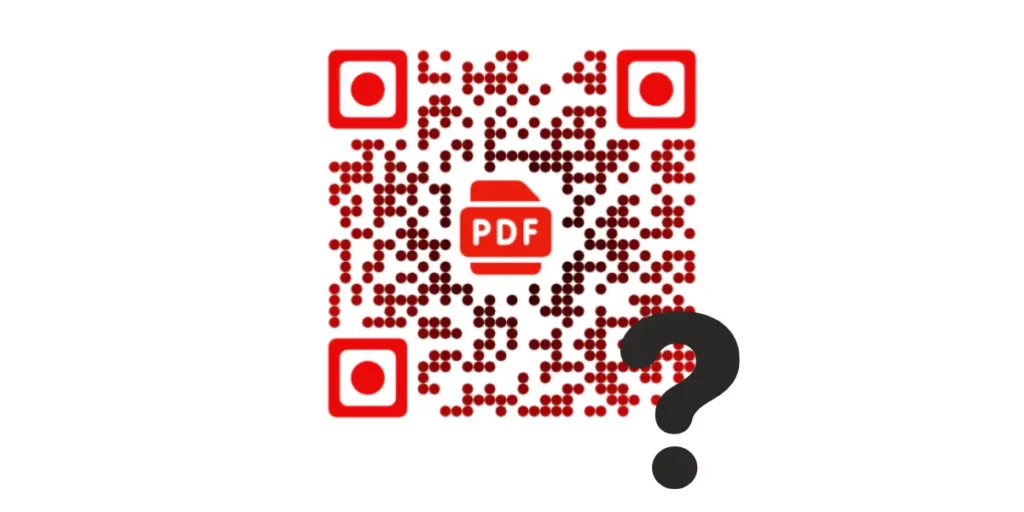
A QR Code for a PDF is like a digital shortcut that connects people to your PDF content with a simple scan. It’s a clever way to bridge the gap between the physical and digital worlds, offering instant access to your PDF material.
Scanova Insight: Did you know? Our recent stats reveal that PDF QR Codes are the second most used QR Code category, making up 17.36% of all QR Codes created.
You can easily create one using a document to a QR Code generator. Just scan the code using a smartphone or QR reader app, and voila! Your PDF pops up, ready to be explored. It’s all about making information easily accessible and hassle-free for your audience.
B. How to create a PDF QR Code

Using Scanova for a demo, here’s how to create a PDF QR Code:
1. Go to Scanova, and from the dashboard, click on Create QR Code
2. From QR Code categories, select Document QR Code
3. Click Upload and upload the PDF that you want to encode into your QR Code. Once done, click on Continue.
4. Next, you will see the option to name your QR Code. Note that it is a dynamic QR Code, which means you can edit it anytime and even track its scanning activity
This is unlike a static QR Code which is basic and cannot be edited once created.
5. Once you add a suitable name, click on Create QR Code
6. Now, on the page you land, you will be able to see QR Code details. Add design to the QR Code
Under the QR Code image, you will be able to see the Edit Design option. You can use it to customize your QR Code. Once you click on it, you’ll see two QR Code design options:
Custom logo design: Here, you can add a logo to the center. In addition to this, you can also change the color and pattern of the QR Code’s eyes and data modules
Custom background design: It allows you to superimpose your QR Code on a background image. It also gives you the option to change the pattern of both QR Code’s eyes and data modules
7. Once you’ve finalized the QR Code design, Update it and proceed to click on the Download button
8. Next, a window will pop up prompting you to sign up for a 14-day free trial. Once you do it, you’ll also be able to assign tags to your QR Code to be able to search it in the future
9. Next, you can proceed to Download your QR Code. Simply specify the size and format of the QR Code image to be downloaded. Once you do it, click on Export
That’s how easy it is to convert a PDF to QR Code!
C. Who can use a QR Code for PDF
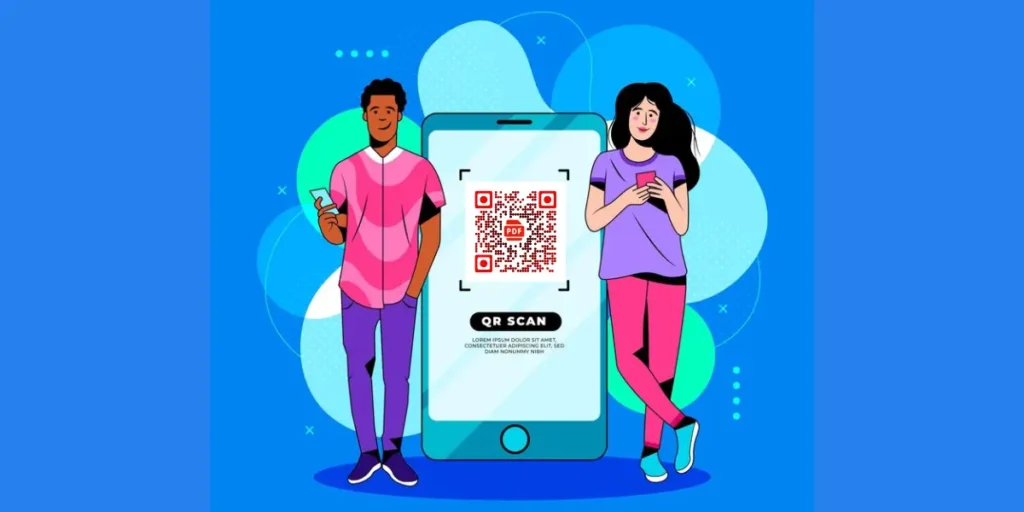
1. Business owners
Whether you’re steering a bustling startup or a seasoned enterprise, QR Codes for PDFs are your secret weapon for dazzling customers.
Picture this: sleek product catalogs, enticing pricing guides, or exclusive deals – all accessible with a simple scan. It’s like handing out golden tickets to your digital kingdom!
Did you know? Statista report predicts that mobile QR Code scanner usage in the U.S. will surpass 100 million users by 2025.
2. Educators
Calling all knowledge enthusiasts! With PDF QR Codes, education takes on a whole new dimension.
Imagine students diving into a world of interactive course materials, from dynamic lecture notes to captivating study guides. Learning becomes an adventure, with QR Codes as the treasure map!
3. Marketers
Ah, the thrill of the marketing arena! QR Code form PDFs are your trusty steed, galloping into the hearts of your audience. Picture this: handing out brochures that leap to life with a scan, whisking potential customers away on a journey of discovery. With QR Codes, engagement is just a tap away!
4. Content creators
Hey there, digital trailblazers! QR Codes are your passport to creativity.
Picture this: sharing downloadable guides, eBooks, or exclusive content that leaves your audience hungry for more. It’s like sprinkling magic dust on your content, turning followers into loyal fans!
5. Event organizers
Lights, camera, action – it’s event time!
With QR Codes, you’re the master of ceremonies, orchestrating an unforgettable experience for attendees.
From dynamic schedules to insider info, every scan unlocks a world of excitement, keeping the crowd buzzing with anticipation!
6. Authors
Step into the spotlight, wordsmiths! With QR Codes, your stories reach new heights of enchantment.
Picture this: readers scanning your book cover and diving into a world of bonus content, author interviews, and behind-the-scenes magic. It’s like inviting them into your literary universe!
7. Government agencies
Attention all public servants! QR Codes are your trusty allies in the quest for citizen engagement.
Picture this: distributing forms, reports, or emergency alerts with a simple scan, ensuring that vital information reaches those who most need it. With QR Codes, communication is seamless, and communities thrive!
8. Nonprofits
Heartfelt crusaders, unite! With PDF QR Code, your mission becomes a beacon of hope. Picture this: sharing impactful stories, donation forms, and volunteer opportunities that inspire a wave of support.
9. Real estate agents
Welcome to the world of property magic! With QR Codes, you’re the ultimate matchmaker, connecting buyers with their dream homes.
Picture this: sharing property listings, virtual tours, and neighborhood guides that turn house hunting into an adventure.
10. Restaurants
Hungry for success? With QR Codes, you’re serving up a feast for the senses! Picture this: sharing mouthwatering menus, tantalizing offers, and loyalty rewards that keep customers coming back for more.
11. Travel industry
Bon voyage, adventurers! With QR Codes, you’re the captain of wanderlust, guiding travelers on unforgettable journeys. Picture this: sharing city guides, travel itineraries, and exclusive deals that ignite the spirit of exploration.
12. Medical professionals
Healing heroes, unite! With QR Codes, you’re empowering patients to take charge of their well-being. Picture this: sharing appointment forms, health tips, and informational brochures that make healthcare a breeze.
In 2016, 73 million new PDF files were saved daily in Google Drive and Gmail. Source: Swifdoo
D. Why use a PDF QR Code

Here are some different reasons to use QR Codes for PDFs:
1. Instant access
QR Codes provide immediate access to PDF content with a simple scan, eliminating the need for manual typing of URLs or searching through websites.
For example: In September 2024, Gov. Gavin Newsom signed a bill allowing student IDs to include QR Codes linking to local mental health resources. Instead of just announcing it traditionally, he placed a QR Code in the center of the memo, which when scanned, led to a PDF of the actual bill with the content and his signature. Source: Business Insider
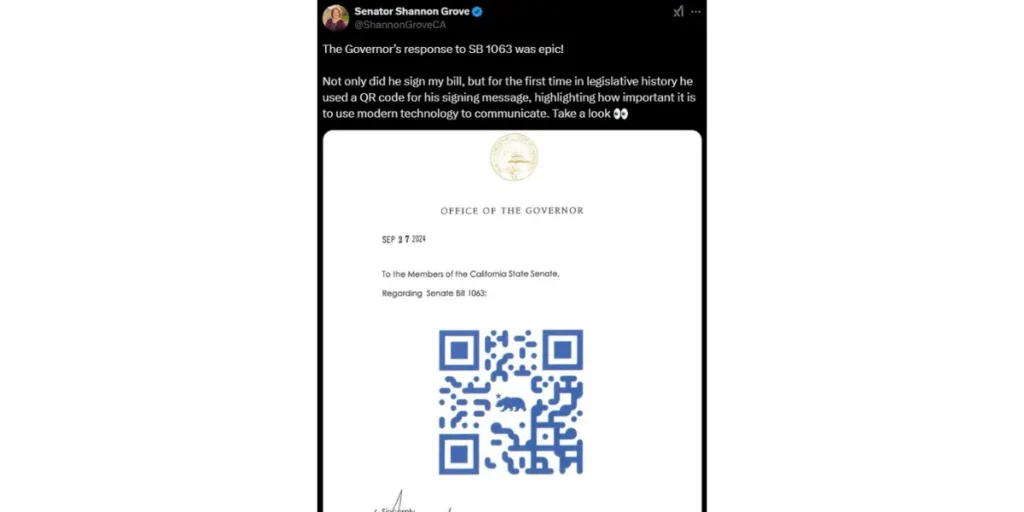
2. Space efficiency
QR Codes can store a large amount of data within a small space, making them ideal for linking to lengthy PDF documents without cluttering physical materials.
3. Cross-platform compatibility
A PDF QR Code can be scanned by virtually any smartphone or tablet, regardless of the operating system, making them accessible to a wide range of users.
4. Offline engagement
QR Code form PDFs allow for seamless engagement with digital content in offline environments such as events, conferences, or product packaging, expanding your reach beyond online channels.
5. Interactive marketing
Incorporating QR Codes into marketing materials adds an interactive element that can enhance user experience and encourage further interaction with your brand or content.
6. Data collection
QR Codes can be used to gather data about user engagement, such as the number of scans, location data, and time of scan, providing valuable insights for marketing analysis and strategy refinement.
7. Enhanced customer experience
By providing quick access to helpful resources or information, QR Codes contribute to a positive customer experience, fostering loyalty and satisfaction.
8. Environmental sustainability
Using a PDF QR Code to distribute digital documents reduces the need for printed materials, contributing to environmental sustainability efforts by reducing paper waste.
9. Security and control
QR Codes can be linked to password-protected PDFs, allowing for the secure distribution of sensitive information while maintaining control over access permissions.
Password protection is a good start, but it doesn’t prove if a file is real. For sensitive reports or certificates, tools like QR Mark add an extra layer of trust by placing a scannable code on the document itself for instant verification.
10. Educational tools
In educational settings, a PDF QR Code can be used to supplement traditional learning materials with multimedia content, interactive quizzes, or additional reading materials, enhancing the learning experience for students.
11. Promotional opportunities
QR Codes can be integrated into promotional campaigns to offer exclusive discounts, access to gated content, or entry into contests or sweepstakes, driving engagement and incentivizing action.
12. Ease of implementation
Generating and using PDF QR Codes in marketing materials or digital platforms is a straightforward process that requires minimal time and resources, making it a practical solution for businesses of all sizes.
What our customers say about us:
E. When to use a PDF QR Code

1. On-demand access
A PDF QR Code provide instant access to detailed information or resources. For example, include QR Codes on product labels in-store, directing customers to PDF manuals or specifications for further information.
2. Offline interactions
Enhance printed materials like brochures or posters with QR Codes. These codes can lead users to PDF documents containing additional details, videos, or interactive content related to the material.
3. Event promotion
Use QR Codes on event invitations or posters to provide attendees with access to PDFs containing event schedules, speaker bios, or downloadable resources like presentation slides.
4. Educational resources
In textbooks or educational presentations, integrate QR Codes that lead students to PDFs with supplementary readings, practice exercises, or multimedia content to deepen their understanding of the topic.
5. Marketing campaigns
Incorporate QR Codes into digital marketing materials such as email newsletters or social media posts. These codes can direct users to PDFs with exclusive offers, product catalogs, or whitepapers to drive engagement and conversions.
6. Product information
On product packaging or labels, include QR Codes that link to PDF manuals, assembly instructions, or warranty details. This provides customers with easy access to important product information right at the point of purchase.
7. Service offerings
Use QR Codes on service brochures, business cards, or signage to direct users to PDFs with detailed service descriptions, pricing packages, or appointment booking forms, making it easy for them to learn more and take action.
8. Training and development
In employee training materials or workshop handouts, include QR Codes that lead to PDFs with training manuals, instructional videos, or certification resources, allowing participants to access relevant content on the go.
Developed by Adobe Inc. between 1998 and 2008, the PDF format was standardized as ISO 32000 in 2008. Before this standardization, companies wishing to create, sell, use, distribute, or develop PDF-compliant implementations were required to pay patent royalties to Adobe, as PDF was a proprietary format. Source: Swifdoo
F. Where to use a PDF QR Code
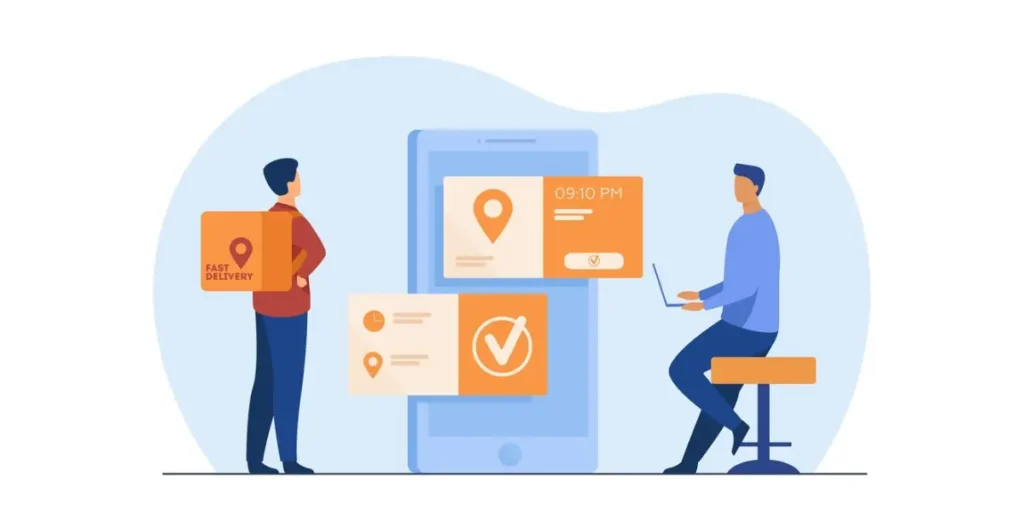
1. Packaging inserts
Include QR Codes on packaging inserts that link directly to PDF manuals, troubleshooting guides, or instructional documents related to the product. This provides customers with easy access to comprehensive information right when they need it.
For example, many tech brands are now including QR Codes as packaging inserts with their gadgets. Such QR Code is used to convert instructional manual PDF to QR Code.
2. Business cards
Add a QR Code to your business card that leads contacts to a PDF portfolio, resume, or company brochure, allowing them to learn more about your services or expertise with just a scan.
3. Menu enhancements
Incorporate QR Codes into restaurant menus that direct diners to PDF versions of the menu, special offers, or nutritional information. This gives customers access to detailed information and updates about your offerings.
4. Event tickets
Integrate QR Codes into event tickets that link to PDF tickets on attendees’ smartphones. This streamlines the ticketing process, reduces paper waste, and provides a convenient way for attendees to manage their tickets digitally.
5. Instructional labels
Include QR Codes on instructional labels for products or equipment that lead users to PDF guides, safety manuals, or troubleshooting tips. This empowers users to access important information quickly and easily.
6. Property signage
Utilize QR Codes on property signage or For Sale/For Rent signs that direct potential buyers or tenants to PDF property brochures, floor plans, or virtual tours. This enhances the property viewing experience and provides detailed information to interested parties.
7. Newsletter sign-ups
Place QR Codes in-store or at events that link to PDF sign-up forms for newsletters, loyalty programs, or exclusive offers. This simplifies the sign-up process for customers and encourages them to stay engaged with your brand.
8. Travel itineraries
Use QR Codes in travel itineraries or booking confirmations that lead travelers to PDF documents containing trip details, hotel information, or excursion schedules. This ensures travelers have all the necessary information at their fingertips during their journey.
9. Product demonstrations
Include QR Codes on product displays or demonstration materials that link to PDF guides, tutorials, or case studies. This provides customers with additional resources to enhance their understanding of the product and its features.
10. Educational signage
Integrate QR Codes into educational signage or displays that lead students or visitors to PDF documents containing supplementary information, historical context, or multimedia content related to the topic. This enriches the educational experience and encourages further exploration.
G. Best practices: PDF QR Code
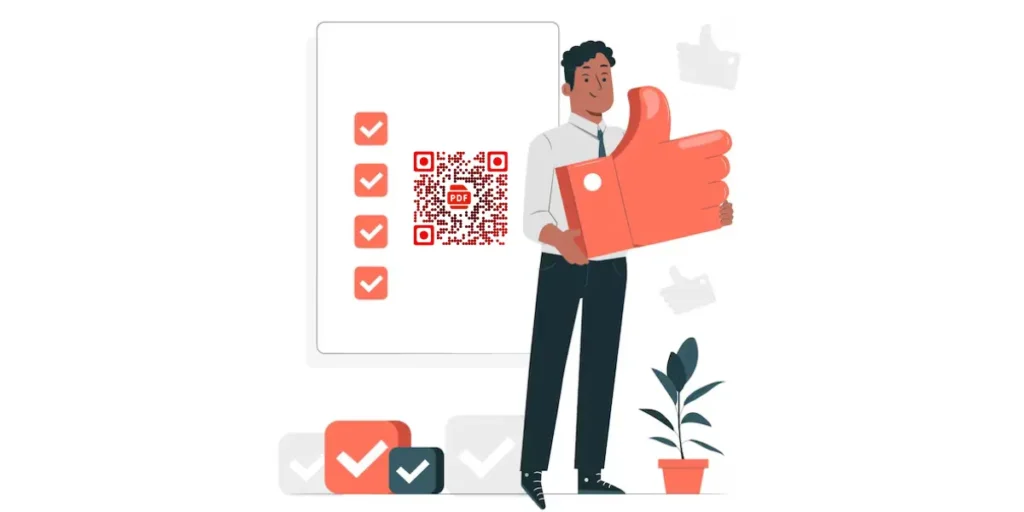
Here are some best practices specifically for converting PDF to QR Code:
1. Use high-quality PDFs
Ensure that the PDF documents you are linking to are high-quality, well-formatted, and optimized for digital viewing. This ensures a positive user experience when accessing the content via the QR Code.
2. Test QR Code scanning
Test the QR Codes with various smartphones and QR Code scanning apps to ensure compatibility and readability across different devices and operating systems.
3. Provide clear instructions
Include clear instructions near the QR Code, indicating what users can expect when they scan it. For example, “Scan to access product manual” or “Scan for event agenda.”
4. Optimize PDF size
Keep the size of the linked PDF file reasonable to minimize loading times and ensure a smooth user experience, especially for mobile users with limited bandwidth or slower internet connections.
5. Customize QR Code design
Customize the design of the PDF QR Code to align with your brand identity and make it visually appealing. However, ensure that the code remains scannable by maintaining a high contrast between the QR Code and its background.
6. Provide value
Ensure that the content of the linked PDF provides value to users and aligns with their expectations when scanning the QR Code. Whether it’s product instructions, event details, or educational materials, make sure it meets their needs.
7. Track and analyze usage
Implement tracking mechanisms to monitor the usage of QR Codes linking to PDFs. This data can provide insights into user engagement, content effectiveness, and campaign performance, helping you refine your strategies over time.
8. Update content regularly
Keep the content of the linked PDFs up-to-date and relevant to ensure that users receive accurate information when they scan the QR Code. Regularly review and update the content as needed to reflect any changes or updates.
9. Offer mobile-friendly viewing
Optimize the PDF documents for mobile viewing to ensure readability and usability on smartphones and tablets. Consider factors such as font size, layout, and navigation to provide a seamless viewing experience on smaller screens.
10. Secure sensitive content
If the linked PDF contains sensitive or confidential information, consider implementing security measures such as password protection or encryption to protect the data from unauthorized access.
H. FAQs: QR Code for PDF

1. Can you make a QR Code for a PDF?
Yes! You can create a QR Code for a PDF by either uploading the PDF link to a QR Code generator or directly uploading the PDF file. Scanova even allows you to upload up to 20 PDFs at once.
2. What are the benefits of using QR Codes for PDF documents?
Explore the advantages of using QR Codes to link to PDF documents, such as easy access to information, enhanced user engagement, and streamlined communication.
3. How to make a QR Code for a PDF?
To make a QR Code for a PDF, follow these steps: Go to app.scanova.io/qr/create > Select the Document QR Code category > Click on Upload > Upload PDF > Click continue > Name your QR Code > Click Create QR COde > Customize design > Sign up and Download.
4. Can I change my PDF file using the same QR Code?
Yes! If you’re creating a QR Code by uploading the file, it is dynamic in nature. This means you can change the linked PDF file using the same QR Code, and it will now link to the new file.
5. Can QR Codes for PDFs be customized?
Learn about the customization options available for QR Codes, such as adding branding elements, changing colors, or incorporating logos, to align with your brand identity or campaign theme.
6. Is my data (PDFs) safe with a QR Code generator?
When using a QR Code generator, the safety of your data, such as PDFs, is ensured through various security measures and compliance with standards like GDPR, ISO/IEC 27001, and HIPAA. Reputable generators use advanced encryption to protect data during transmission and storage, and they host services on secure servers with regular security audits. Strict access controls, often incorporating multi-factor authentication, limit data access to authorized personnel. These generators also follow data minimization and retention policies, ensuring data is only kept as long as necessary and is securely deleted when no longer needed. By adhering to these security protocols, QR Code generators ensure your data remains confidential and secure.
7. Are there any tips for designing QR Codes for PDFs?
Discover best practices for designing QR Codes to ensure they are visually appealing, easily recognizable, and scannable across different devices and platforms.
8. How can I promote QR Codes for PDFs effectively?
Explore strategies for promoting QR Codes to encourage users to scan them, such as including clear calls-to-action, offering incentives, or providing context about the linked PDF content.
9. What types of PDF content are most suitable for QR Code linking?
Find out which types of PDF documents are well-suited for linking with QR Codes, such as product manuals, event agendas, educational materials, promotional brochures, or instructional guides.
10. Can QR Codes for PDFs be tracked and analyzed?
Learn about tracking and analytics tools that allow you to monitor the performance of QR Codes, track user engagement, and gather insights into how users interact with the linked PDF content.
11. Are there any common mistakes to avoid when using QR Codes for PDFs?
Identify common pitfalls or mistakes to avoid when creating and implementing QR Codes for PDFs, such as using low-quality images, linking to irrelevant content, or neglecting to test the codes beforehand.
12. What are some creative ways to use QR Codes for PDFs?
Explore innovative applications of QR Codes for PDFs, such as incorporating them into interactive exhibits, scavenger hunts, or immersive marketing experiences to engage users in unique ways.
13. Can QR Codes for PDFs be used for educational purposes?
PDF QR Codes can be used in educational settings to provide students with access to supplemental learning materials, interactive quizzes, or multimedia resources stored in PDF format.
14. Are there any privacy or security considerations when using QR Codes for PDFs?
Learn about potential privacy or security risks associated with using QR Codes, such as unauthorized access to linked PDF content or the collection of user data, and how to mitigate these risks effectively.
Summing Up
With a PDF QR Code, you can effortlessly deliver instant access to valuable content, enriching user experiences and enabling you to track engagement metrics for continual improvement.
Whether you’re sharing product manuals, event agendas, educational resources, or promotional materials, the QR Code for PDF serves as a versatile conduit for placing information directly into the hands of your audience.
So, why delay? Dive into the realm of PDF QR Codes today, infusing your marketing efforts, educational initiatives, and customer communications with an innovative flair that leaves a lasting impact.
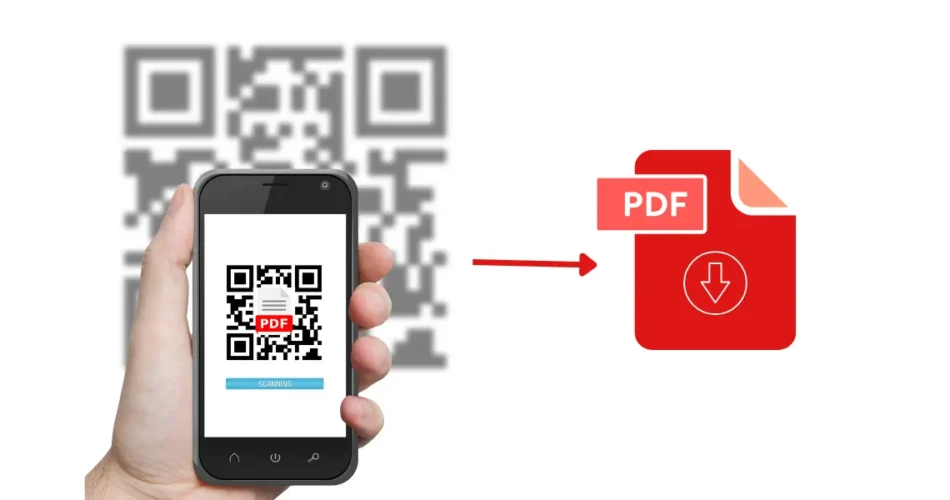


every time i try to upload my pdf file and wait for it to full upload i click on “creat my QR code” an error message comes from the down right corner said “please upload pdf file” when i’m already upload it .. it’s .pdf and about 300 M
Hey Atheer,
You can only upload a PDF with a size up to 20 MB to create a PDF QR Code.
Hope this was helpful.
May I check, when I successfully create a PDF QR Code, is there a validity to that QR Code (being that It’s a free trial)
Hey Cindy,
The free trial is valid for 14 days.
I want to include a scan code on the label for the customers to see the analysis report of the product. Every year I have to produce a new analysis report, as a new batch. Can I replace the new pdf document with the previous year and use the same QR Code on my labels?
HiBob,
Yes, you can easily do that by creating a Dynamic QR Code. A Dynamic QR Code can be updated anytime. The updated QR Code remains the same and you do not need to create or reprint a new QR Code.
Since you link a PDF to your QR Code, here is a helpful guide on how to create a Dynamic PDF QR Code:
https://scanova.io/blog/how-to-create-a-qr-code-for-a-pdf/
hi, is there any way to create a qr code that can be used when the user is offline?
Thanks
Hey,
If you’ve encoded simple text in a static QR Code, the end-users will be able to scan the QR Code to see the content even without an internet connection. But for the QR Codes that have a website link, document files, images, videos, etc. the users will need an internet connection to access the encoded content.
Hope this helps.
Hey there!
I want to develop QR code for pdf and I want that whenever operator scans that QR code; it should neither get downloaded on phone nor operator able to take its screenshot.
Kindly help me out with this issue!
Hey Prabin,
That’s currently not possible with our service.
Hi I would like to buy pdf to qr code generator software from your company. Please guide what plans are available.
Hi Harish,
You can check out our pricing plans here: https://scanova.io/pricing.html
Good